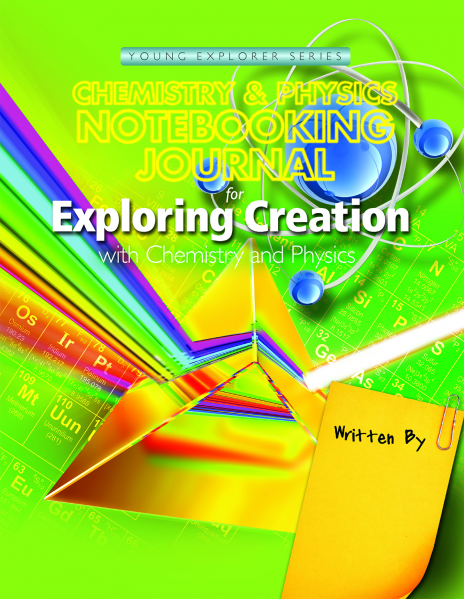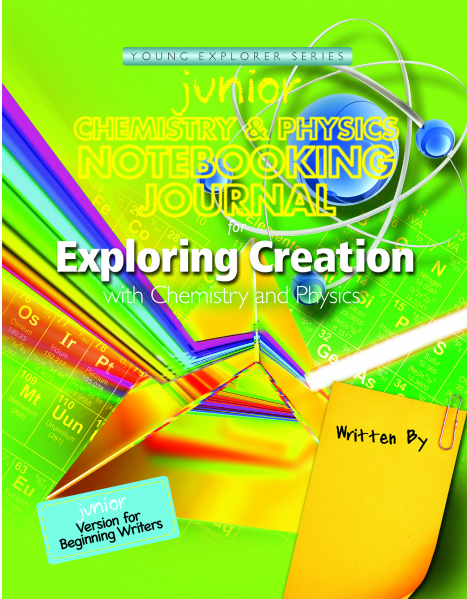


When the books arrived, I took some time to look through them, but realized that there really isn't much prep work involved. It appeared to be pretty much open and start reading. SCORE! The only thing I did was flip to the experiment supply list and start collecting the items we needed for the first week and read through the "How to use this book" section in the front of the book.
The book is written as if the author, Jeannie Fulbright, is talking directly to the student. It was easy to just pick up and start reading and it explained it to ME as I was reading it to them. ;) It is all clearly Bible based and intent on teaching the kids about the wonderful world that God made. She doesn't speak above the kids level, but doesn't talk down to them either. I would love to have her actually sitting here teaching my kids, but this is a good substitute. ;)
I read each section aloud while P colored in her journal and T took notes (and doodled) in his. After we finished a section, I had P (and T if he had missed any) write the "vocab" words and definitions in her journal and do a little illustration of each one. There are so many experiments sprinkled in each chapter that really helped bring the science to life. Most of the supplies were common household items that we had laying around. It was great and the kids loved it. After the first day, P woke up wanting to do science first because "it was her favorite." They both made lava lamps and took them to CC to use as their presentations for the day.
We started out using the daily schedule in the notebooking journals, but ended up tweaking it a little. It has each lesson divided into two weeks. Because the kids loved it to much (and to get through more chapters to get a better feel for the review), we did this four days a week (CC on Mondays so didn't do it then) instead of two like suggested so split each day up. The time we spent on science varied a little, depending on the assignment. Normally, I would read a few pages to them and then we would stop at the "try this" sections and do several experiments or activities. It took us around 45 minutes a day with the reading, experimenting, and discussing.
Then we would do something in the notebook. Sometimes that was copying a scripture (loved that they have it in both print and cursive...I had them do both, but on two different days during the week), doing a crossword, or making a little flap book with their words and definitions in them. P's Junior Notebook has color pages in it, which she colored while I was reading each day.
When they finished the first lesson, they were supposed to write a play on Archimedes. Captain C had just studied Archimedes so he was able to jump in and help them with this. It was really cute. I keep meaning to have them redo it so I can video it and share it. T called dibs on getting to jump out of the tub naked and yell, "Eureka!" and run through the house. We all agreed that was a good role for him...IF he put a towel around his waist. Crazy kid. Here we were pretending the Little People were Archimedes as we were seeing how different things displace the water.
Each of their notebooking journals had different, age appropriate activities in them. The basic ideas were the same in each of them though so it was easy to teach off both of them. The kids didn't mind when they had to do different things and I only heard one time that "it isn't fair" that P had color sheets and T didn't. ;) The biggest difference is in the size of space available for writing. The junior notebook has wider lines, with dashes in the middle and the normal notebook just has plain lines. Sometimes P had a word search instead of a crossword puzzle, but nothing too drastically different.
We loved this science curriculum. I have no complaints at all about the content of the program. I love having God centered lessons and the kids retained what they learned. There really was only one thing that bugged me....the words are printed too close to the center of the book. I know that is petty and silly but it bugged me everyday when I was reading to have to "scroll" over (aka...squish the book down) to see it all.
I highly recommend this to anyone with kids ages 6-13. I think it can actual go for older as the material is so good and thoroughly taught. I'm looking forward to continuing through the book and notebooks until we finish it in the spring.
The textbook costs $39.00 and each of the journals were $24.00. I like that there is no teacher's guide to worry about and there is so much to do in the books that this will easily cover a full year of science. Read what other great TOS reviewers have to say about their experiences with Apologia by clicking the banner below.











No comments:
Post a Comment
I would love to hear your thoughts!!